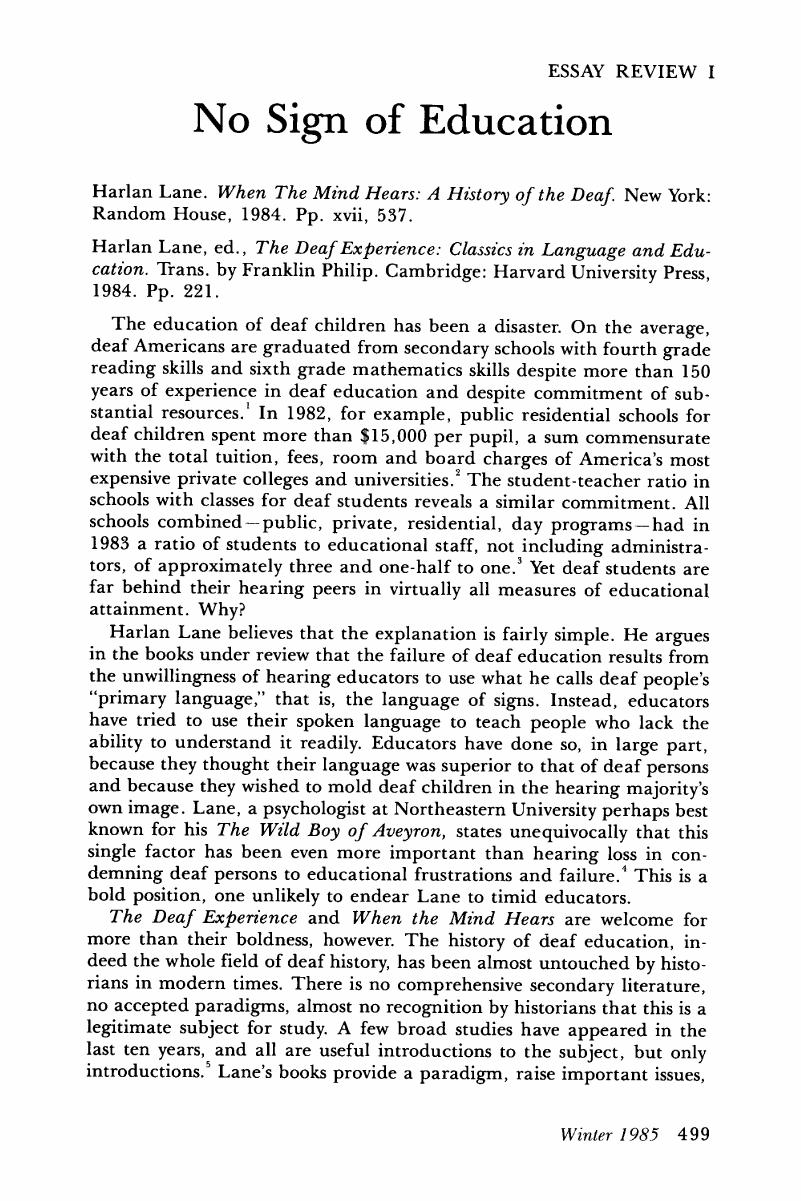No CrossRef data available.
Published online by Cambridge University Press: 24 February 2017

1. Moores, Donald F., Educating the Deaf: Psychology, Principles, and Practices, 2d ed. (Boston, 1982), 297.Google Scholar
2. “Financial Statement — Public Residential Schools in the United States, October 1, 1982,” American Annals of the Deaf 128 (April 1983):217–226.Google Scholar
3. “Tabular Summary of Schools and Classes in the United States, October 1, 1983,” American Annals of the Deaf 129 (April 1984):188–189.Google Scholar
4. Lane, Harlan, The Wild Boy of Aveyron (Cambridge, Mass., 1976); Lane, Harlan, When the Mind Hears (New York, 1984), 387.Google Scholar
5. See Moores, , Educating the Deaf; Gannon, Jack R., Deaf Heritage: A Narrative History of Deaf America, ed. Butler, Jane and Gilbert, Laura-Jean (Silver Spring, Md., 1981); Lane, Harlan and Grosjean, Francois, eds. Recent Perspectives on American Sign Language (Hillsdale, N.J., 1980); Flint, Richard W., “History of the Education of the Hearing Impaired,” in Hearing and Hearing Impairment , ed. Bradford, Larry J. and Hardy, William G. (New York, 1979), 19–37; Scouten, Edward L., Turning Points in the Education of Deaf People (Danville, Ill. 1984).Google Scholar
6. See Bellugi, Ursula and Klima, Edward S., Signs of Language (Cambridge, 1979); Stokoe, William C. Jr., Casterline, Dorothy C., and Croneberg, Carl G., eds., A Dictionary of American Sign Language on Linguistic Principles (Washington, D.C., 1965); Schein, Jerome D., The Deaf Community: Studies in the Social Psychology of Deafness (Washington, D.C., 1968); Meadows, Kathryn P., “The Deaf Subculture,” Hearing and Speech Action 43 (July-August 1975): 16–18; Charrow, Veda R. and Wilbur, Ronnie B., “The Deaf Child as a Linguistic Minority,” Theory into Practice 14 (December 1975): 357–8; Higgins, Paul C., Outsiders in a Hearing World: A Sociology of Deafness (Beverly Hills, Calif, 1980); Nash, Jeffrey E. and Nash, Anedith, Deafness in Society (Lexington, Mass., 1981); Baker, Charlotte and Battison, Robbin, eds., Sign Language and the Deaf Community: Essays in Honor of William Stokoe (Silver Spring, Md, 1980); Lane, and Grosjean, , Recent Perspectives .Google Scholar
7. Two examples already in print are Schuchman, John S., “Silent Movies and the Deaf Community,” Journal of Popular Culture 17 (Spring 1984): 58–78; and Van Cleve, John V., “Nebraska's Oral Law of 1911 and the Deaf Community,” Nebraska History 65 (Summer 1984):195–220. Others will appear in Gallaudet Encyclopedia of Deaf People and Deafness ed. Van Cleve, John V. (forthcoming).Google Scholar
8. Lane, , Deaf Experience, 1.Google Scholar
9. Ibid., 26.Google Scholar
10. Ibid., 35.Google Scholar
11. Ibid., 148.Google Scholar
12. Ibid., 127.Google Scholar
13. Lane, , When the Mind Hears, 340.Google Scholar
14. Rothman, David J., The Discovery of the Asylum: Social Order and Disorder in the New Republic (Boston, 1971).Google Scholar
15. Lane, , When the Mind Hears, 387.Google Scholar
16. Information compiled by the reviewer from Columbia Institution for the Deaf and Dumb and Blind: Statistics of Pupils. Gallaudet College Archives, Gallaudet College, Washington, DC.Google Scholar
17. Gannon, , Deaf Heritage, 422.Google Scholar
18. No study specifically about these individuals has been published. However, the Volta Review, a journal published by the Alexander Graham Bell Association, occasionally carries articles by or about orally educated deaf individuals.Google Scholar